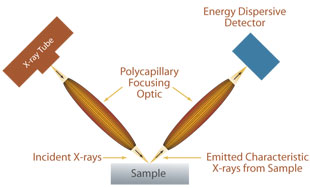- Analyzers
- Optics & Sources
- Technologies
- Support
- About
Applications of XRF: Confocal X-Ray Fluorescence
The confocal geometry uses two polycapillary focusing optics for enhanced applications of XRF elemental analysis. An excitation optic focuses a small X-ray beam onto the specimen. A detection optic collects fluorescent X-rays from the sample. Specifically, elemental concentrations are measured within the small probe volume (“confocal volume”) defined by the intersection of the output focal spot of the excitation optic and the input focal spot of the collection optic.

This method can be used to detect and quantify elements within radioactive materials. The polycapillary focusing optics act as spatial filters to eliminate background radiation from the sample and increase detection sensitivity for sample elements of interest. Additionally, confocal XRF can be used for elemental depth profiling. Confocal XRF acts as a material probe by exciting and detecting emitted characteristic X-ray photons from within the confocal analysis volume as this volume is through the sample. In this way elemental concentrations can be measured on the object’s surface and throughout the object’s interior. Confocal X-ray fluorescence with X-ray optics has been used for many unique applications including thin film thickness measurement, forensics, art restoration, and small feature analysis.

